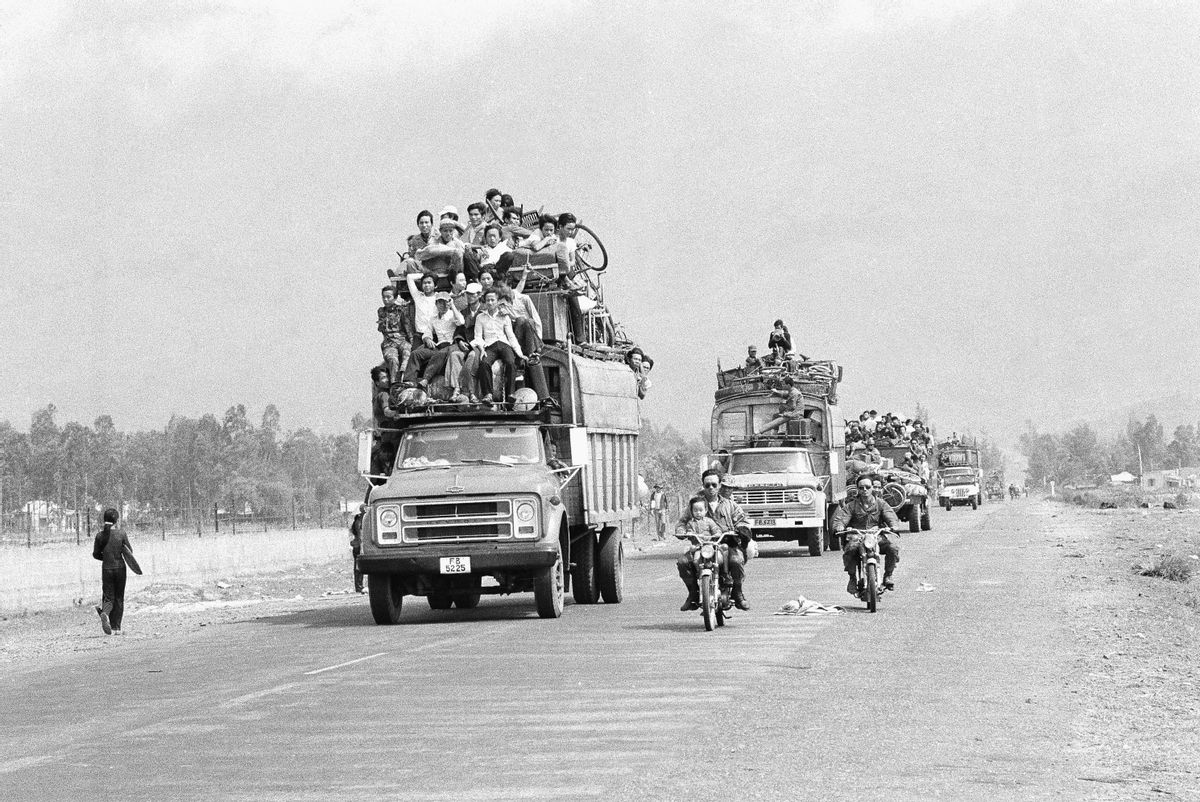More than 120,000 people fled Vietnam after the North Vietnamese captured Saigon on April 30, 1975.
This chaotic evacuation has been captured in iconic photos, documentary films and oral histories. How did the Vietnamese seeking safety actually get from small boats or rooftop helicopters to the United States?
First, they went to Guam.
In response to the emergency, the U.S. military established a refugee camp on this small island in the Pacific. On Guam, the U.S. government planned to assess the crisis and process individuals while preparing camps on the mainland for the incoming Vietnamese. However, approximately 1,500 Vietnamese had another idea – refusing resettlement in the U.S. and returning home.
I first learned of these events when I discovered images of the repatriates in the U.S. National Archives and found “Ship of Fate,” the memoir of a South Vietnamese naval officer, Tran Dinh Tru. His story and that of other repatriates shows the real risks of repatriation if there are no guarantees of protection. This is an important lesson today given the U.S. government’s current steps to make it harder for refugees to enter the country.
Captain Tran Dinh Tru
Tru was a respected career South Vietnamese naval officer. In the chaos of April 1975, Tru evacuated with other naval officers, and he organized for a ship to save his wife, who was stranded far outside Saigon. However, the ship failed to rescue his wife. Like many family members across South Vietnam, she was left behind with their three children to navigate the new political landscape.
Waiting on Guam alone, Tru despaired that he would never see his family again.
Tru was one of more than 1,500 Vietnamese on Guam who did not want to resettle in America. They called themselves the repatriates, and they wanted to return to Vietnam for a range of reasons.
Many were young South Vietnamese sailors who were aboard South Vietnamese ships as the North Vietnamese advanced on Saigon, and their captains had directed the ships out to sea and never returned to port. These young men did not see themselves as refugees.
In other cases, older men and women decided they did not have the stamina to start again in America. Others, like Tru, had family members who had missed connections, and they faced indefinite separation.
The repatriates turned to the United Nations High Commissioner for Refugees (UNHCR), the U.S. government and the Guamanian public to make the case that they should be allowed to return to Vietnam. They wrote letters to the Guam newspaper and built massive billboards within the camp demanding their return. The UNHCR and the U.S. could not guarantee their safety on return, and so they made no plans for their repatriation. Frustrated with the lack of action, many of the repatriates escalated their protests.
The repatriates built a makeshift stage. Men shaved their heads in front of a banner that proclaimed boldly in English, “Thirty-Six Hours, Hunger Sit-In, Quiet, Hair Shaving Off, To Pray for a Soon Repatriation.” The repatriates also organized hunger strikes, militant marches through the streets of Guam and eventually set fire to buildings in the refugee camp.
This was a situation no one had anticipated. The repatriates did not want to go to the United States, the Guamanian government did not want them to stay on Guam and the U.S. government did not know what to do. Notably, the new Vietnamese government did not want them back.
The ship of fate
In the end, the U.S. government granted the Vietnamese a commercial ship, the Viet Nam Thuong Tin, to return home. Tru agreed to be the captain due to his experience and skill. The Vietnamese repatriates knew the communist government saw them as hostile interlopers, traitors and possible CIA plants, but they still felt strongly that they must return.
The voyage took roughly two weeks, and the atmosphere on the ship was tense and cautious.
When the ship arrived in Vung Tau, a southern Vietnamese port, the Vietnamese government saw Tru as suspect and counterrevolutionary. They ignored his repeated wishes to reunite with his family, and the government imprisoned Tru in its network of “reeducation camps,” where he suffered for 13 years. These camps punished South Vietnamese men who had fought against North Vietnam and allied themselves with South Vietnam and the United States. They combined prison labor and forced ideological training. They were marked by hunger, indefinite detention, and ongoing physical and psychological hardship.
My research into the limited reports of these events shows that the repatriates’ sentences ranged from months to many years. As captain, Tru suffered their arbitrary brutality the longest.
Tru eventually resettled in the United States with his family in 1991.
It’s worth noting that Tru’s long voyage is unusual. Most of the more than 120,000 Vietnamese who fled Vietnam sought and soon gained resettlement in the United States. President Gerald Ford’s administration allowed them to enter as “parolees” – a loophole in U.S. immigration policy, which did not make provisions for refugees at that time.
However, by the time Tru was released and decided to immigrate to the United States, he was able to do so through the U.S. Humanitarian Operation program. The U.S. government designed this program for South Vietnamese officers and reeducation camp survivors in the late 1980s, and it expedited immigration processes for this population who had suffered directly because of their affiliations with the United States. The U.S. accepted over 70,000 Vietnamese who had been imprisoned in Vietnam.
![]() In my view, the Vietnamese repatriates’ story challenges us to recognize the risks and fears individuals face in moments of crisis, and ponder the difficult decisions that must be made at the end of a war.
In my view, the Vietnamese repatriates’ story challenges us to recognize the risks and fears individuals face in moments of crisis, and ponder the difficult decisions that must be made at the end of a war.
Jana Lipman, Associate Professor of History, Tulane University



Shares